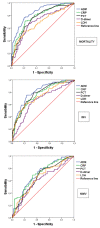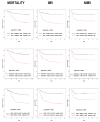Predictive Value of MR-proADM in the Risk Stratification and in the Adequate Care Setting of COVID-19 Patients Assessed at the Triage of the Emergency Department
- PMID: 36010321
- PMCID: PMC9406922
- DOI: 10.3390/diagnostics12081971
Predictive Value of MR-proADM in the Risk Stratification and in the Adequate Care Setting of COVID-19 Patients Assessed at the Triage of the Emergency Department
Abstract
In the past two pandemic years, Emergency Departments (ED) have been overrun with COVID-19-suspicious patients. Some data on the role played by laboratory biomarkers in the early risk stratification of COVID-19 patients have been recently published. The aim of this study is to assess the potential role of the new biomarker mid-regional proadrenomedullin (MR-proADM) in stratifying the in-hospital mortality risk of COVID-19 patients at the triage. A further goal of the present study is to evaluate whether MR-proADM together with other biochemical markers could play a key role in assessing the correct care level of these patients. Data from 321 consecutive patients admitted to the triage of the ED with a COVID-19 infection were analyzed. Epidemiological; demographic; clinical; laboratory; and outcome data were assessed. All the biomarkers analyzed showed an important role in predicting mortality. In particular, an increase of MR-proADM level at ED admission was independently associated with a threefold higher risk of IMV. MR-proADM showed greater ROC curves and AUC when compared to other laboratory biomarkers for the primary endpoint such as in-hospital mortality, except for CRP. This study shows that MR-proADM seems to be particularly effective for early predicting mortality and the need of ventilation in COVID-19 patients admitted to the ED.
Keywords: COVID-19 biomarkers; emergency department; mid-regional proadrenomedullin; triage.
Conflict of interest statement
The authors declare no conflict of interest.
Figures



Similar articles
-
Correlation between Chest Computed Tomography Score and Laboratory Biomarkers in the Risk Stratification of COVID-19 Patients Admitted to the Emergency Department.Diagnostics (Basel). 2023 Aug 31;13(17):2829. doi: 10.3390/diagnostics13172829. Diagnostics (Basel). 2023. PMID: 37685368 Free PMC article.
-
MR-proADM as Prognostic Factor of Outcome in COVID-19 Patients.Biomedicines. 2023 Jun 9;11(6):1680. doi: 10.3390/biomedicines11061680. Biomedicines. 2023. PMID: 37371775 Free PMC article.
-
Biomarkers and clinical scores to identify patient populations at risk of delayed antibiotic administration or intensive care admission.Crit Care. 2019 Oct 29;23(1):335. doi: 10.1186/s13054-019-2613-4. Crit Care. 2019. PMID: 31665092 Free PMC article.
-
Mid-regional pro-adrenomedullin as a supplementary tool to clinical parameters in cases of suspicion of infection in the emergency department.Expert Rev Mol Diagn. 2021 Apr;21(4):397-404. doi: 10.1080/14737159.2021.1902312. Epub 2021 Mar 29. Expert Rev Mol Diagn. 2021. PMID: 33736553 Review.
-
Circulating mid-regional proadrenomedullin is a predictor of mortality in patients with COVID-19: a systematic review and meta-analysis.BMC Infect Dis. 2023 May 8;23(1):305. doi: 10.1186/s12879-023-08275-z. BMC Infect Dis. 2023. PMID: 37158819 Free PMC article.
Cited by
-
Correlation between Chest Computed Tomography Score and Laboratory Biomarkers in the Risk Stratification of COVID-19 Patients Admitted to the Emergency Department.Diagnostics (Basel). 2023 Aug 31;13(17):2829. doi: 10.3390/diagnostics13172829. Diagnostics (Basel). 2023. PMID: 37685368 Free PMC article.
-
Evaluation of Hepcidin Level in COVID-19 Patients Admitted to the Intensive Care Unit.Diagnostics (Basel). 2022 Nov 2;12(11):2665. doi: 10.3390/diagnostics12112665. Diagnostics (Basel). 2022. PMID: 36359509 Free PMC article.
References
-
- Melbye H., Stocks N. Point of Care Testing for C-Reactive Protein—A New Path for Australian GPs? Aust. Fam. Physician. 2006;35:513–517. - PubMed
-
- Jin M., Khan A.I. Procalcitonin: Uses in the Clinical Laboratory for the Diagnosis of Sepsis. Lab. Med. 2010;41:173–177. doi: 10.1309/LMQ2GRR4QLFKHCH9. - DOI
LinkOut - more resources
Full Text Sources
Research Materials
Miscellaneous

